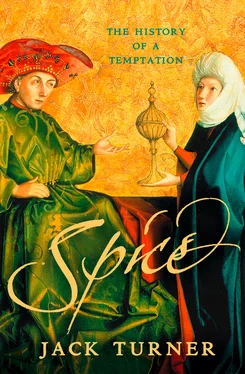By his premature death, Magellan had forfeited the fortune and glory for which he had abandoned his country; as a Portuguese in the service of Spain he won only the opprobrium of his motherland and the suspicions of his adopted country. (Had he lived to return to Spain he would, almost certainly, have fallen foul of court intrigue.) The honours went to the survivor who piloted the Victoria back into Sanlúcar, a native of Guetaria by the name of Juan Sebastián de Elcano, one of the participants in the mutiny against Magellan at Port St Julián. But to the survivor went the spoils. Elcano was rewarded with a coat of arms with the device of a globe set above two cinnamon sticks, twelve cloves and three nutmegs, flanked by two Malay kings grasping branches of a spice tree, blazoned with the motto ‘ Primus circumdedisti me ’ – ‘You were the first to encompass me’.
As the durable Spaniard had outlasted his Portuguese commander, so it seemed on the larger stage of diplomacy. When the Victoria limped back into harbour the tables appeared to have been turned. With a claim staked on Tidore, the Spanish crown now had a physical presence to back up its theoretical claim to sovereignty over the Moluccas. Yet even now there were more twists and turns in store. The border town of Badajoz was the scene of fierce debates between Spanish and Portuguese diplomats, the key issue the still unanswerable question of the Moluccas’ exact longitude. (As a matter of fact, they were indeed in the Portuguese zone, though that could not be confirmed for many years yet.) The Spanish pointed to their presence on Tidore; the Portuguese called them trespassers; the Spanish flung back the same insult. Talks ground on, one futile deposition succeeding another. In the end, a settlement came not from the diplomats but from the accountants of the royal treasury in Madrid. By the terms of the treaty of Zaragoza of 1529, the impecunious Spanish monarch, deaf to the pleading of his counsellors, traded his claim to the Spice Islands for the sum of 350,000 ducats, so as to pay for the ceremonies attending his forthcoming marriage. The Spanish claim to the Moluccas, purchased with so much ingenuity, sweat, cash and blood, was sold to fund a royal wedding.
It was an ignoble end to the enterprise. Many voices – among them de Haro’s – were raised in protest at the king’s short-termism. With the annual profit from the islands estimated at 40,000 ducats, the settlement represented less than a decade’s return. Compounding the investors’ disappointment was the fact that so far these profits had failed to materialise. Even the return of the Victoria had brought de Haro and the other investors little cheer. Among the quayside celebrations, one of the interested parties prepared a breakdown of the expedition’s costs and returns in a document unearthed three hundred years later by the scholar Martín Fernández Navarrete. Known as the ‘discharge document’, this unadorned summary of inputs and outputs makes for fascinating reading. Though at only eighty-five tons the second-smallest vessel of the expedition, the leaking hold of the Victoria yielded 381 bags of cloves, the legacy of the frantic buying that followed its arrival on Tidore. The net weight was calculated at 520 quintals, one arroba and eleven pounds: 60,060 pounds, or 27,300 kilograms. There were also samples of other spices: cinnamon, mace and nutmeg, plus, oddly, one feather (a bird of paradise?).
In the debit column alongside is a listing of expenses: weapons, victuals, hammers, lanterns, drums ‘ para diversión’, pitch and tar, gloves, one piece of Valencian cochineal, twenty pounds of saffron, lead, crystal, mirrors, six metal astrolabes, combs, coloured velvets, darts, compasses, various trinkets and other sundry expenses. Taking into account the loss of four of the five ships, the advances paid to the crews, back pay for the survivors and pensions and rewards for the pilot, it emerges that once the Victoria ’s 381 bags of cloves had been brought to market the expedition registered a modest net profit. For the investors it was a disappointment, paltry in comparison with the astronomical returns then being enjoyed by Portuguese in the East; but it was a profit nonetheless. The conclusion must rate as one of accountancy’s more dramatic moments: a small hold-full of cloves funded the first circumnavigation of the globe.
It is an orchard of delights. With all the sweetness of spices. Paradise as described in the Cursor Mundi, a Northumbrian poem written c.1325.
Columbus, da Gama and Magellan, the three standard-bearers of the age of discovery, were spice-seekers before they became discoverers. Many lesser names followed where they had led. In the wake of their first groping feelers into the unknown, other navigators, traders, pirates and finally armies of various European powers hunted down the source of the spices and squabbled, bloodily and desperately, over their possession.
After the early successes of the Iberian powers, the spice trade took a Protestant turn. At the close of the sixteenth century English and Dutch traders made their first appearance in Asian waters, impelled by a desire for spice, as Conrad would phrase it, that burned in their breasts ‘like a flame of love’. Better organised and more ruthless than any traders yet seen in Atlantic or Asian waters, they fought off the Catholic powers, each other and all Asian rivals and smugglers for the advantage of bringing spices direct to Amsterdam’s Herengracht or London’s Pepper Lane.
At the hands of the northern newcomers Portugal’s Estado da India endured a protracted, undignified senescence, though it was barely a century old. Raiders preyed on the corpse and lopped off the choicest pieces. The first Dutch ships called at the North Moluccas in 1599, returning to Amsterdam low in the water from the weight of the cloves they carried: ‘So long as Holland has been Holland,’ one crewmember claimed, ‘such richly laden ships have never been seen.’ The English followed them east in 1601, James Lancaster leading a fleet under the auspices of the newly formed ‘Company of Merchants of London trading into the East Indies’ – better known as the East India Company. * Sailing from the Javanese port of Bantam, an English pinnace reached the Bandas and their nutmeg groves in March 1603. Others followed, setting sail in vessels with such optimistic names as Clove or Peppercorn. With a toehold on the tiny islands of Ai and Run, James I was, for a time, proud to style himself ‘King of England, Scotland, Ireland, France, Puloway and Puloroon’. For the sake of their nutmeg the latter two tiny islands shade Bermuda as England’s first overseas possessions.
Though these early voyages enjoyed mixed results, malaria, scurvy and inexperience taking a heavy toll, the northern intruders soon struck at the ‘Portingall’ with devastating swiftness. The first assets to go were the remotest, the distant Spice Islands. Here a handful of Portuguese, having long since incurred the loathing of the Muslim population, clung on in a state of permanent siege in a string of mouldering forts. Ternate fell in 1605. Shortly after the Dutch seized the Portuguese fort on Ambon, midway between the North and South Moluccas. Worse was to come, as the conquests of da Gama and his successor Albuquerque (1453–1515) were steadily rolled back. In the disastrous decade of the 1630s, Ceylon and its cinnamon forests fell to combined Ceylonese-Dutch forces – a marriage of convenience the Ceylonese would soon have cause to regret. The Portuguese Jesuit Fernão de Queyroz claimed the Dutch were ‘so disliked by the Natives, that the very stones will rise against them’, but his prediction of independence was some three hundred years premature. Malacca, the bottleneck and entrepôt of the East, surrendered to the Dutch in 1641; the pepper ports of Malabar followed in 1661–63. Spices were now, in effect, a Protestant concern.
Читать дальше











